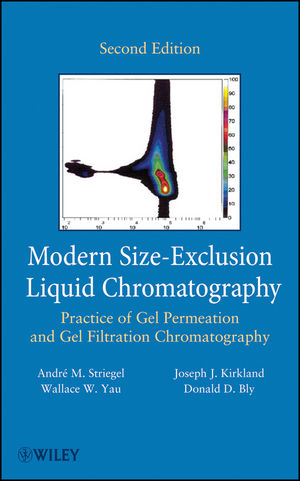Modern Size-Exclusion Liquid Chromatography: Practice of Gel Permeation and Gel Filtration Chromatography, 2nd EditionISBN: 978-0-471-20172-4
Hardcover
512 pages
June 2009
 This is a Print-on-Demand title. It will be printed specifically to fill your order. Please allow an additional 15-20 days delivery time. The book is not returnable.
|
||||||
Preface.
1 Background.
1.1 Introduction.
1.2 History.
1.3 Utility of SEC.
1.4 Molar Mass Averages and Molar Mass Distribution.
1.5 Structure of The Book.
References.
2 Retention.
2.1 Introduction.
2.2 Solute Retention in LC.
2.3 Solute Retention in SEC.
2.4 SEC Retention Mechanism.
2.5 Theoretical Models of SEC Separation.
2.6 Other Considerations.
References.
3 Band Broadening.
3.1 Introduction.
3.2 LC Plate Theory.
3.3 Mechanism of SEC Band Broadening.
3.4 Influencing Factors.
3.5 Experimental Methods.
References.
4 Resolution.
4.1 Introduction.
4.2 Resolution Concept in SEC of Polymers.
4.3 Molar Mass Accuracy Criterion.
4.4 Applications of Column Performance Criteria .
4.5 Pore Geometry and Operational Effects.
References.
5 Equipment.
5.1 Introduction.
5.2 Extra-Column Effects: General.
5.3 Mobile-Phase Reservoirs, Inlet Filters, and Degassers.
5.4 Solvent-Metering Systems (Pumps).
5.5 Sample Injectors and Autosamplers.
5.6 Miscellaneous Hardware.
5.7 Laboratory Safety.
References.
6 The Column.
6.1 Introduction.
6.2 Column Packings.
6.3 Column-Packing Methods.
6.4 Column Performance.
References.
7 Experimental Variables and Techniques.
7.1 Introduction.
7.2 Solvent Effects.
7.3 Substrate Effects.
7.4 Sample Effects.
7.5 Laboratory Techniques.
7.6 Solvent Selection and Preparation.
7.7 Selection and Use of Standard Reference Materials.
7.8 Detector Selection.
7.9 Column Selection and Handling.
7.10 Chromatographic Design Considerations.
7.11 Making the Separation.
7.12 Troubleshooting.
References.
8 Calibration.
8.1 Introduction.
8.2 Calibration with Narrow-MMD Standards.
8.3 Calibration with Broad-MMD Standards.
8.4 Accuracy of Calibration Methods.
8.5 Actual Molar Mass Across the SEC Elution Curve.
8.6 Linear Calibration Ranges.
8.7 Recent Developments and Recommendations on Band-Broadening Correction.
References.
9 Physical Detectors.
9.1 Introduction.
9.2 Concentration-Sensitive Detectors.
9.3 Static Light-Scattering Detection.
9.4 Quasielastic Light-Scattering Detection.
9.5 Viscometric Detection.
9.6 SEC3.
References.
10 Chemical Detectors.
10.1 Introduction.
10.2 Mass Spectrometry.
10.3 Fourier Transform Infrared Spectroscopy.
10.4 Nuclear Magnetic Resonance Spectroscopy.
10.5 Other Chemical Detectors.
10.6 Coupling of Chemical Detectors.
References.
11 Polymer Architecture and Dilute Solution Thermodynamics.
11.1 Introduction.
11.2 Long-Chain Branching.
11.3 Determining the Short-Chain Branching Distribution.
11.4 Polymer Architecture: Conformation and Topology.
11.5 Star Polymers.
11.6 Determining the Persistence Length.
11.7 Determining the Characteristic Ratio.
11.8 Local Polydispersity.
References.
12 Aqueous SEC.
12.1 Introduction.
12.2 Aqueous SEC Columns.
12.3 Non-Size-Exclusion Effects and Mobile-Phase Additives.
12.4 Select Applications of Aqueous SEC.
References.
13 Oligomeric SEC.
13.1 Introduction.
13.2 What is an Oligomer?
13.3 Preliminary Considerations.
13.4 Oligomeric SEC Columns.
13.5 Select Applications of Oligomeric SEC.
13.6 Optimizing Resolution in Oligomeric SEC.
References.
14 SEC in 2D-LC Separations.
14.1 Introduction.
14.2 Principles of 2D Polymer Separations.
14.3 Designing an Experimental 2D-LC Protocol.
14.4 Eluent Transfer in 2D-LC.
14.5 Stop-Flow SEC × LC.
14.6 Select Applications of 2D-LC.
14.7 SEC in 3D Separations.
References.
15 Special Techniques.
15.1 Introduction.
15.2 Preparative SEC.
15.3 Recycle SEC.
15.4 High-Speed SEC.
15.5 Inverse SEC.
15.6 Vacancy and Differential SEC.
15.7 Size-Exclusion Electrochromatography.
References.
16 High-Temperature SEC and Rheological Connections.
16.1 Introduction.
16.2 High-Temperature SEC.
16.3 Complementarity of SEC and Rheology.
References.
Symbols.
Abbreviations.
Index.



